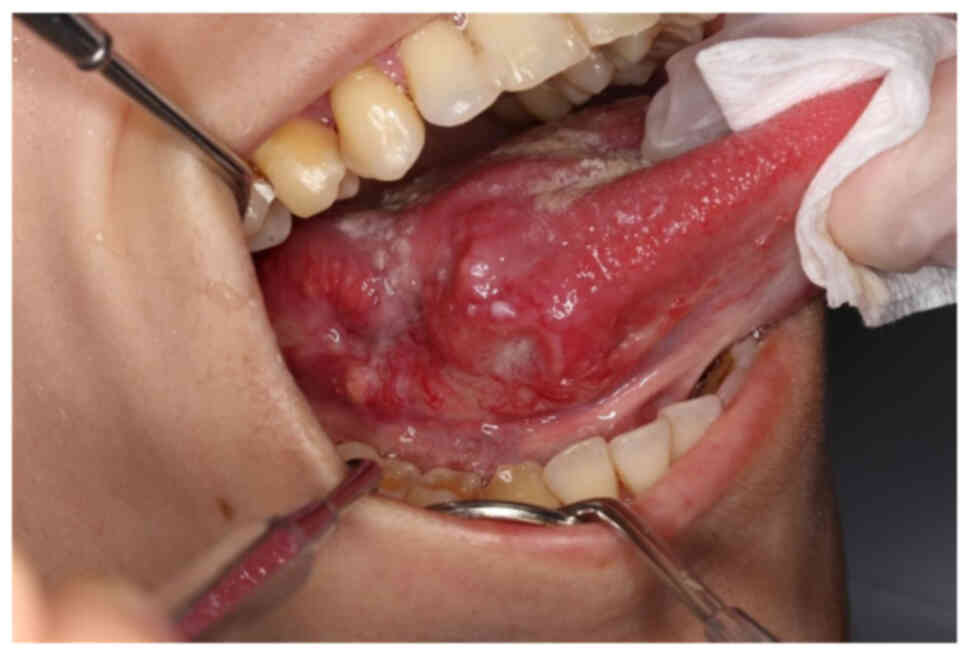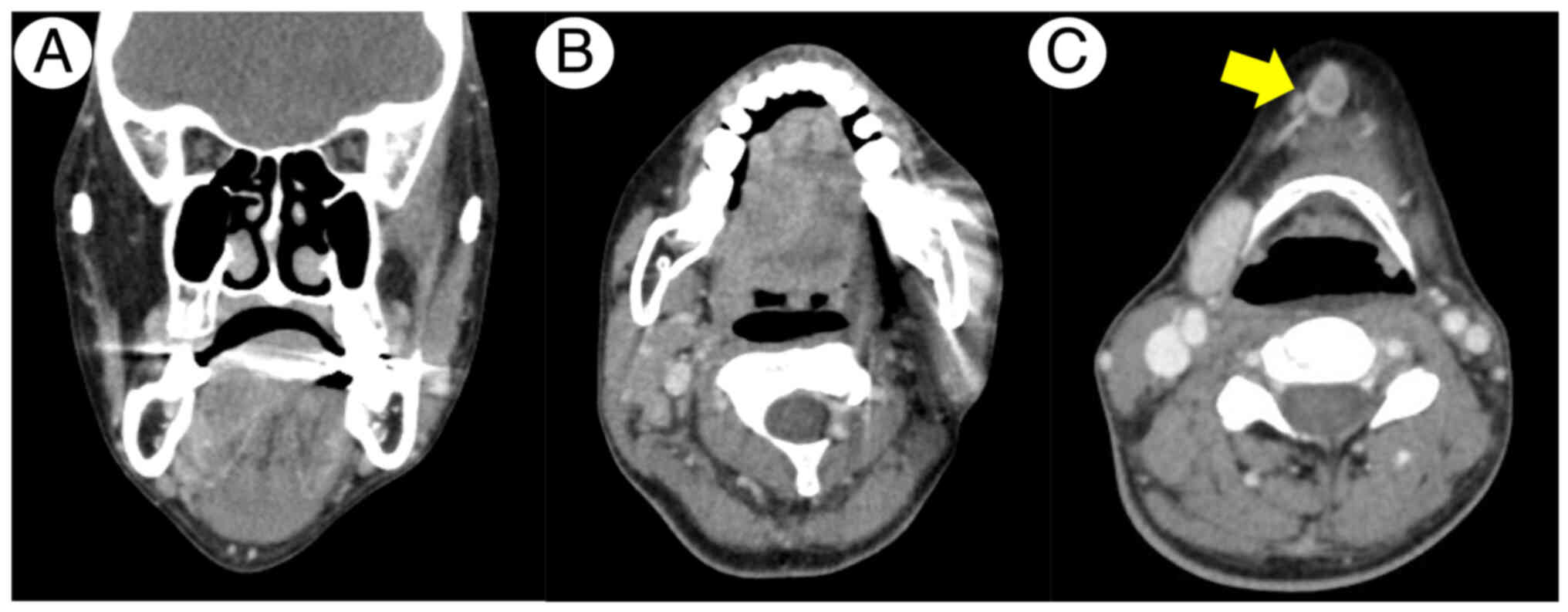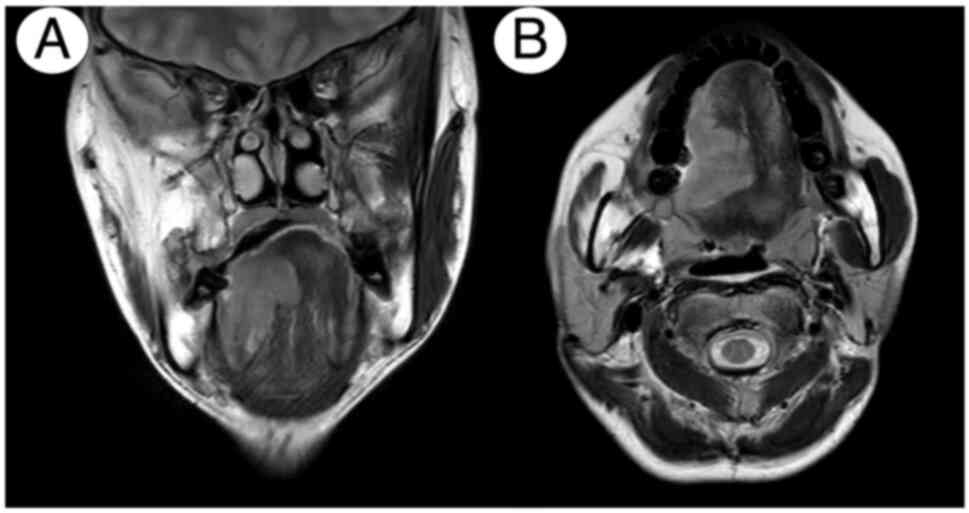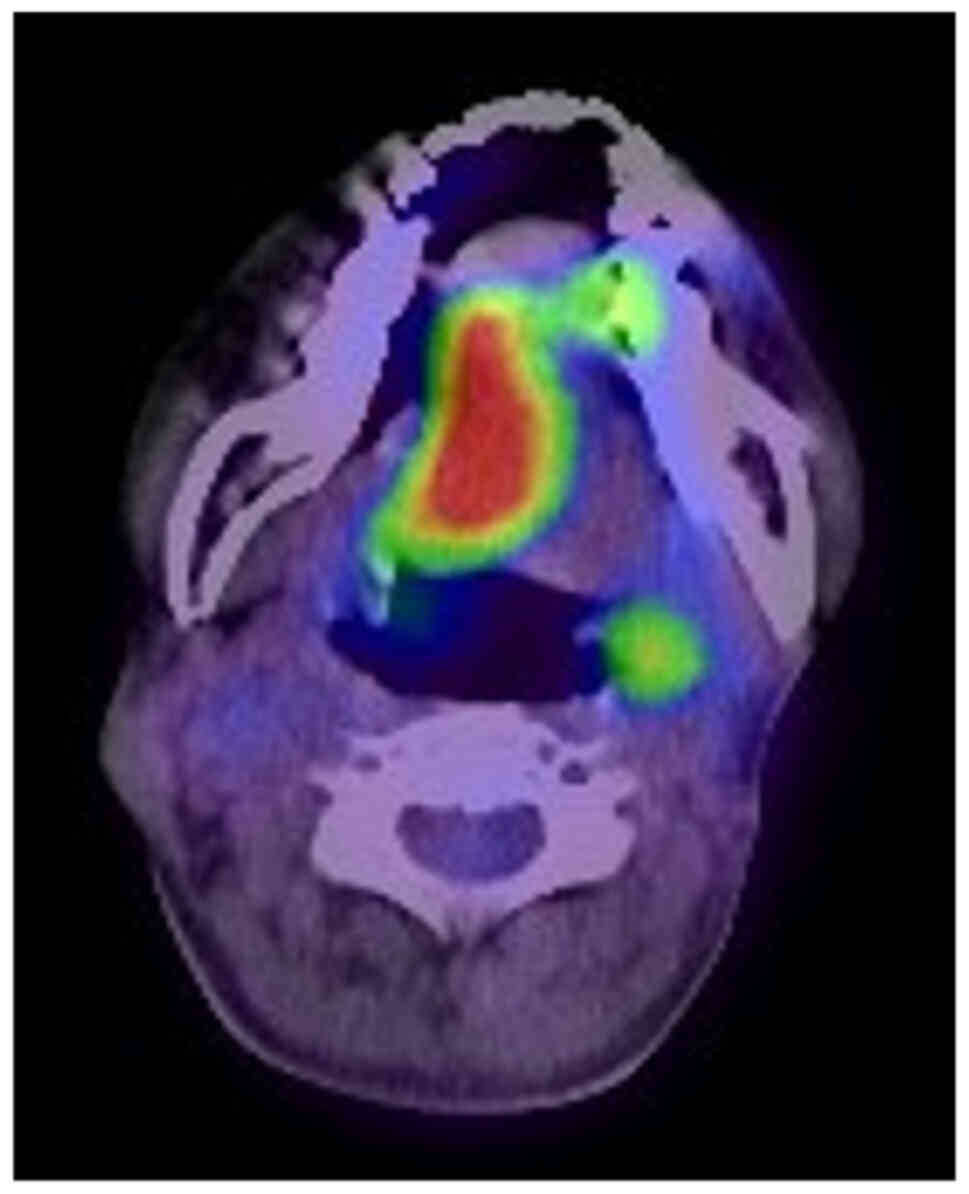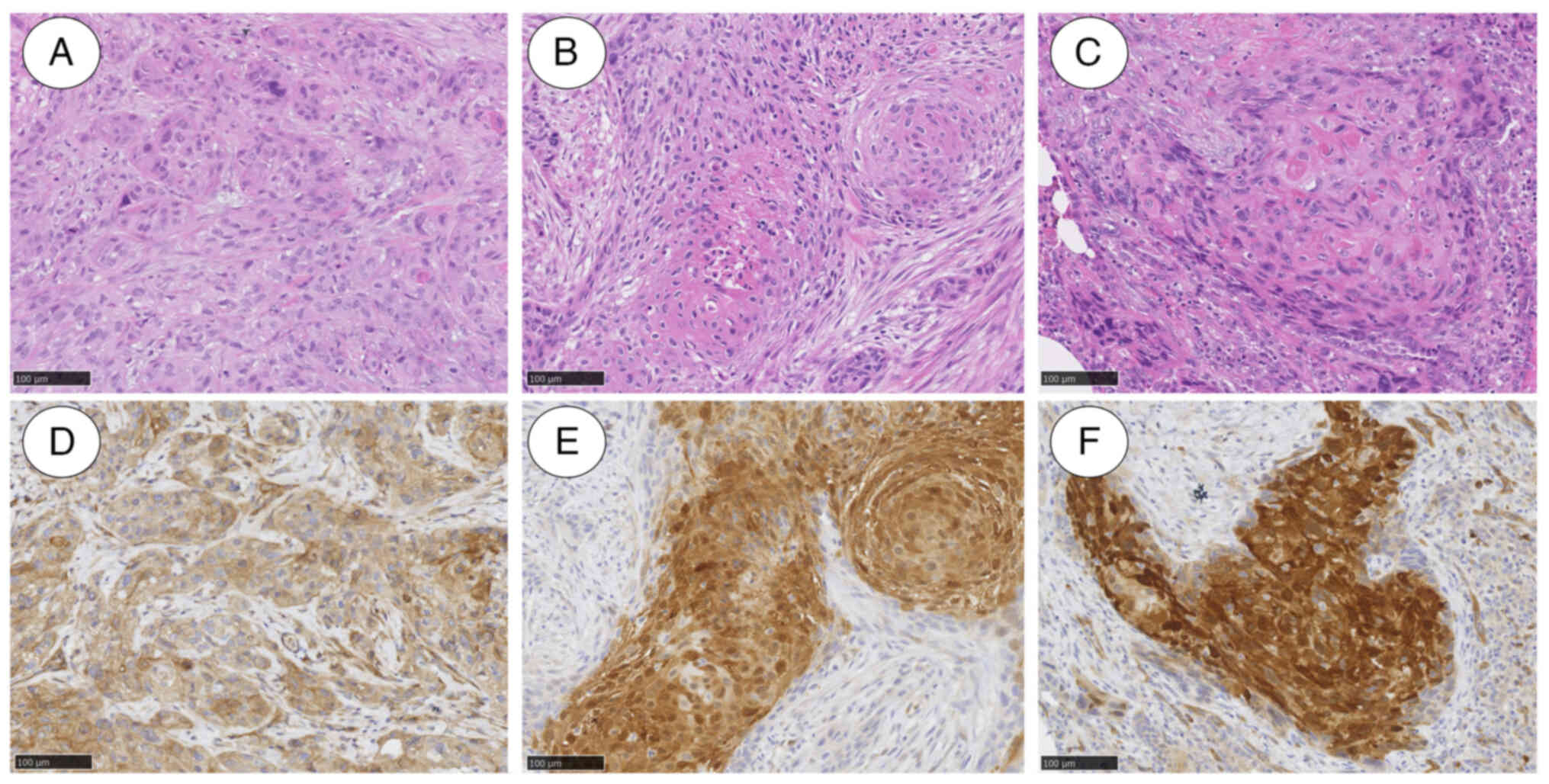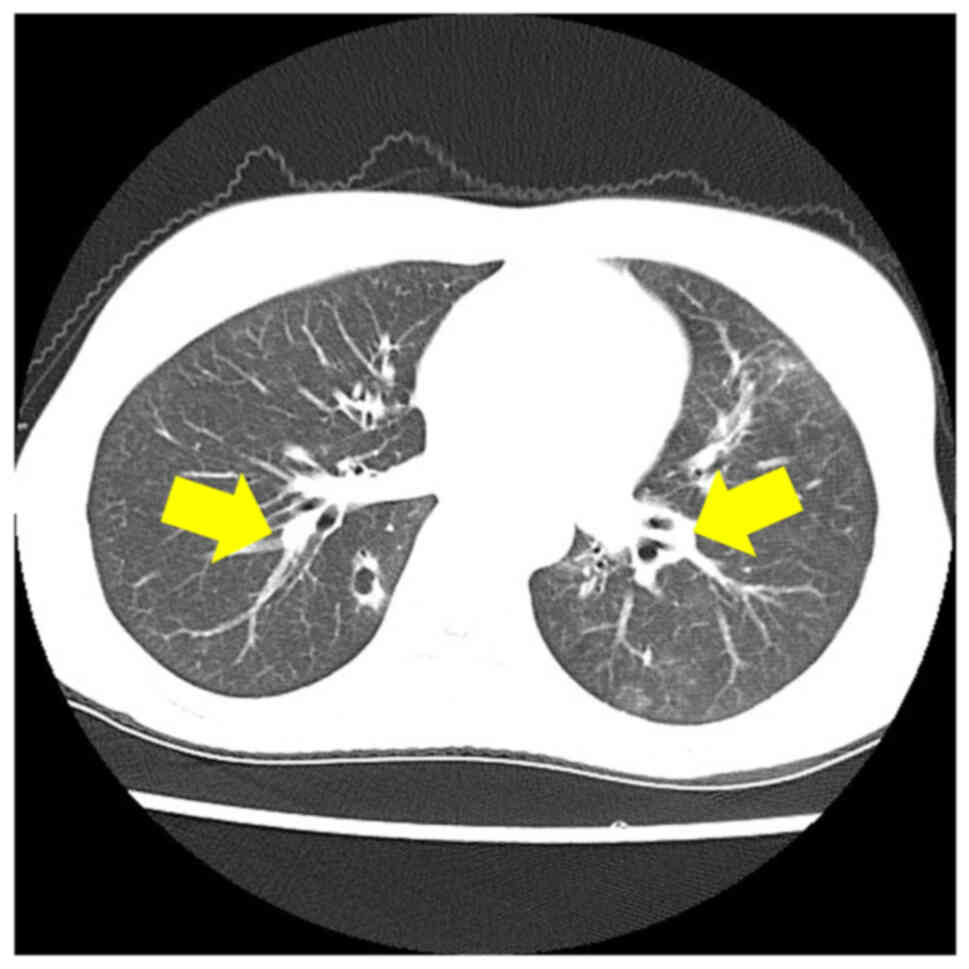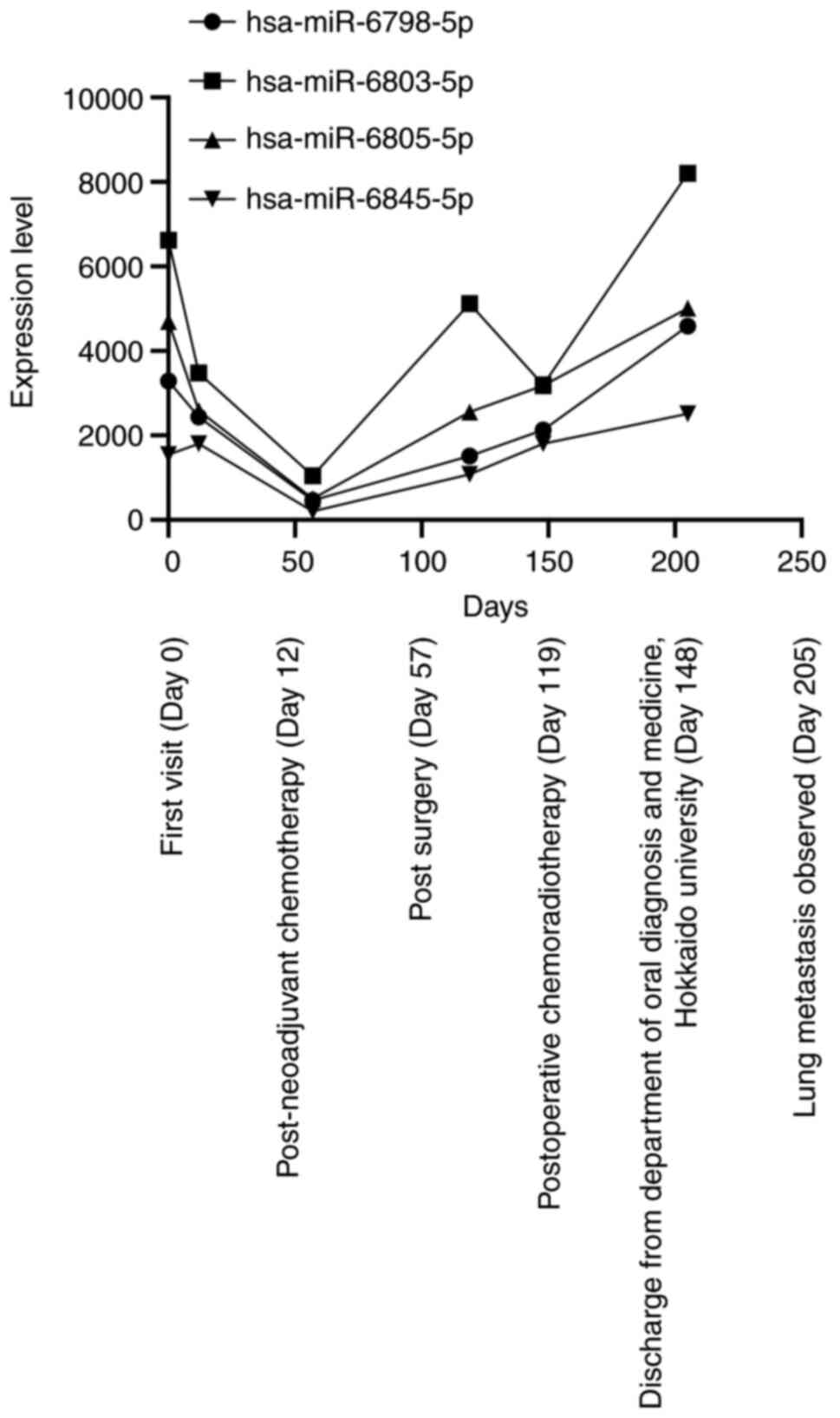|
1
|
Mody MD, Rocco JW, Yom SS, Haddad RI and
Saba NF: Head and neck cancer. Lancet. 398:2289–2299. 2021.
View Article : Google Scholar : PubMed/NCBI
|
|
2
|
Yoshioka Y, Sakaue T, Matsui K, Tsushima
K, Obayashi F, Hamada A, Yamasaki S, Hamana T, Sumi K, Kanda T, et
al: Clinical investigation of oral cancer in adolescent and young
adult generation. Oral Sci Int. 18:126–134. 2021. View Article : Google Scholar
|
|
3
|
Braakhuis BJM, Brakenhoff RH and Leemans
CR: Treatment choice for locally advanced head and neck cancers on
the basis of risk factors: Biological risk factors. Ann Oncol. 23
(Suppl 10):x173–x177. 2012. View Article : Google Scholar : PubMed/NCBI
|
|
4
|
Carreras-Torras C and Gay-Escoda C:
Techniques for early diagnosis of oral squamous cell carcinoma:
Systematic review. Med Oral Patol Oral Cir Bucal. 20:e305–e315.
2015. View Article : Google Scholar : PubMed/NCBI
|
|
5
|
Chow LQM: Head and neck cancer. N Engl J
Med. 382:60–72. 2020. View Article : Google Scholar : PubMed/NCBI
|
|
6
|
Ho PS, Wang WC, Huang YT and Yang YH:
Finding an oral potentially malignant disorder in screening program
is related to early diagnosis of oral cavity cancer-experience from
real world e. Oral Oncol. 89:107–114. 2019. View Article : Google Scholar : PubMed/NCBI
|
|
7
|
Ambros V: The functions of animal
microRNAs. Nature. 431:350–355. 2004. View Article : Google Scholar : PubMed/NCBI
|
|
8
|
Kim T and Croce CM: MicroRNA: Trends in
clinical trials of cancer diagnosis and therapy strategies. Exp Mol
Med. 55:1314–1321. 2023. View Article : Google Scholar : PubMed/NCBI
|
|
9
|
Calin G, Dumitru C, Shimizu M, Bichi R,
Zupo S, Noch E, Aldler H, Rattan S, Keating M, Rai K, et al:
Frequent deletions and down-regulation of micro-RNA genes miR15 and
miR16 at 13q14 in chronic lymphocytic leukemia. Proc Natl Acad Sci
USA. 99:15524–15529. 2002. View Article : Google Scholar : PubMed/NCBI
|
|
10
|
O'Donnell KA, Wentzel EA, Zeller KI, Dang
CV and Mendell JT: c-Myc-regulated microRNAs modulate E2F1
expression. Nature. 435:839–843. 2005. View Article : Google Scholar : PubMed/NCBI
|
|
11
|
Calin GA and Croce CM: MicroRNA signatures
in human cancers. Nat Rev Cancer. 6:857–866. 2006. View Article : Google Scholar : PubMed/NCBI
|
|
12
|
Chen X, Ba Y, Ma L, Cai X, Yin Y, Wang K,
Guo J, Zhang Y, Chen J, Guo X, et al: Characterization of microRNAs
in serum: A novel class of biomarkers for diagnosis of cancer and
other diseases. Cell Res. 18:997–1006. 2008. View Article : Google Scholar : PubMed/NCBI
|
|
13
|
Yap T, Vella L, Seers C, Nastri A,
Reynolds E, Cirillo N and McCullough M: Oral swirl samples-a robust
source of microRNA protected by extracellular vesicles. Oral Dis.
23:312–317. 2017. View Article : Google Scholar : PubMed/NCBI
|
|
14
|
Yap T, Seers C, Koo K, Cheng L, Vella LJ,
Hill AF, Reynolds E, Nastri A, Cirillo N and McCullough M:
Non-invasive screening of a microRNA-based dysregulation signature
in oral cancer and oral potentially malignant disorders. Oral
Oncol. 96:113–120. 2019. View Article : Google Scholar : PubMed/NCBI
|
|
15
|
Balakittnen J, Ekanayake Weeramange C,
Wallace DF, Duijf PHG, Cristino AS, Hartel G, Barrero RA, Taheri T,
Kenny L, Vasani S, et al: A novel saliva-based miRNA profile to
diagnose and predict oral cancer. Int J Oral Sci. 16:142024.
View Article : Google Scholar : PubMed/NCBI
|
|
16
|
Agrawal A, Balcı H, Hanspers K, Coort SL,
Martens M, Slenter DN, Ehrhart F, Digles D, Waagmeester A, Wassink
I, et al: WikiPathways 2024: Next generation pathway database.
Nucleic Acids Res. 52(D1): D679–D689. 2024. View Article : Google Scholar : PubMed/NCBI
|
|
17
|
Passaro A, Al Bakir M, Hamilton EG, Diehn
M, André F, Roy-Chowdhuri S, Mountzios G, Wistuba II, Swanton C and
Peters S: Cancer biomarkers: Emerging trends and clinical
implications for personalized treatment. Cell. 187:1617–1635. 2024.
View Article : Google Scholar : PubMed/NCBI
|
|
18
|
van Schaik JE, Muller Kobold AC, van der
Laan BFAM, van der Vegt B, van Hemel BM and Plaat BEC: Squamous
cell carcinoma antigen concentration in fine needle aspiration
samples: A new method to detect cervical lymph node metastases of
head and neck squamous cell carcinoma. Head Neck. 41:2561–2565.
2019. View Article : Google Scholar : PubMed/NCBI
|
|
19
|
Dar GM, Agarwal S, Kumar A, Nimisha
Apurva, Sharma AK, Verma R, Sattar RSA, Ahmad E, Ali A, et al: A
non-invasive miRNA-based approach in early diagnosis and
therapeutics of oral cancer. Crit Rev Oncol Hematol.
180:1038502022. View Article : Google Scholar : PubMed/NCBI
|
|
20
|
Prakash N and Pradeep G: Circulating
biomarkers in oral cancer: Unravelling the mystery. J Oral
Maxillofac Pathol. 26:300–306. 2022. View Article : Google Scholar : PubMed/NCBI
|
|
21
|
Kinoshita T, Nohata N, Hanazawa T, Kikkawa
N, Yamamoto N, Yoshino H, Itesako T, Enokida H, Nakagawa M, Okamoto
Y and Seki N: Tumour-suppressive microRNA-29s inhibit cancer cell
migration and invasion by targeting laminin-integrin signalling in
head and neck squamous cell carcinoma. Br J Cancer. 109:2636–2645.
2013. View Article : Google Scholar : PubMed/NCBI
|
|
22
|
Manikandan M, Deva Magendhra Rao AK,
Arunkumar G, Manickavasagam M, Rajkumar KS, Rajaraman R and
Munirajan AK: Oral squamous cell carcinoma: microRNA expression
profiling and integrative analyses for elucidation of
tumourigenesis mechanism. Mol Cancer. 15:282016. View Article : Google Scholar : PubMed/NCBI
|
|
23
|
Suh YE, Raulf N, Gäken J, Lawler K, Urbano
TG, Bullenkamp J, Gobeil S, Huot J, Odell E and Tavassoli M:
MicroRNA-196a promotes an oncogenic effect in head and neck cancer
cells by suppressing annexin A1 and enhancing radioresistance. Int
J Cancer. 137:1021–1034. 2015. View Article : Google Scholar : PubMed/NCBI
|
|
24
|
Alimena S, Stephenson BJK, Webber JW,
Wollborn L, Sussman CB, Packard DG, Williams M, Comrie CE, Wang JY,
Markert T, et al: Differences in serum miRNA profiles by race,
ethnicity, and socioeconomic status: implications for developing an
equitable ovarian cancer screening test. Cancer Prev Res (Phila).
17:177–185. 2024. View Article : Google Scholar : PubMed/NCBI
|
|
25
|
Diener C, Keller A and Meese E: Emerging
concepts of miRNA therapeutics: From cells to clinic. Trends Genet.
38:613–626. 2022. View Article : Google Scholar : PubMed/NCBI
|
|
26
|
Li Z and Rana TM: Therapeutic targeting of
microRNAs: Current status and future challenges. Nat Rev Drug
Discov. 13:622–638. 2014. View
Article : Google Scholar : PubMed/NCBI
|
|
27
|
Lu Z, He Q, Liang J, Li W, Su Q, Chen Z,
Wan Q, Zhou X, Cao L, Sun J, et al: miR-31-5p is a potential
circulating biomarker and therapeutic target for oral cancer. Mol
Ther Nucleic Acids. 16:471–480. 2019. View Article : Google Scholar : PubMed/NCBI
|
|
28
|
Torso NDG, Quintanilha JCF, Cursino MA,
Pincinato EC, Loren P, Salazar LA, Lima CSP and Moriel P:
miR-6805-5p as a biomarker of cisplatin-induced nephrotoxicity in
patients with head and neck cancer. Front Pharmacol.
14:12752382023. View Article : Google Scholar : PubMed/NCBI
|
|
29
|
Xiong H, Ni Z, He J, Jiang S, Li X, He J,
Gong W, Zheng L, Chen S, Li B, et al: LncRNA HULC triggers
autophagy via stabilizing Sirt1 and attenuates the chemosensitivity
of HCC cells. Oncogene. 36:3528–3540. 2017. View Article : Google Scholar : PubMed/NCBI
|
|
30
|
Li LB, Yang L, Xie GQ, Zhou XC, Shen XB,
Xu QL, Ma ZY and Guo XD: The modulation relationship of genomic
pattern of intratumor heterogeneity and immunity microenvironment
heterogeneity in hepatocellular carcinoma. Oncol Lett. 20:2332020.
View Article : Google Scholar : PubMed/NCBI
|
|
31
|
Yan S, Jiang Y, Liang C, Cheng M, Jin C,
Duan Q, Xu D, Yang L, Zhang X, Ren B and Jin P: Exosomal
miR-6803-5p as potential diagnostic and prognostic marker in
colorectal cancer. J Cell Biochem. 119:4113–4119. 2018. View Article : Google Scholar : PubMed/NCBI
|
|
32
|
Yan S, Cheng M, Duan Q, Wang Z, Gao W, Ren
B and Xu D: MiR-6803-5p promotes cancer cell proliferation and
invasion via PTPRO/NF-κB axis in colorectal cancer. Mediators
Inflamm. 2019:81285012019. View Article : Google Scholar : PubMed/NCBI
|
|
33
|
Ferrara N, Gerber HP and LeCouter J: The
biology of VEGF and its receptors. Nat Med. 9:669–676. 2003.
View Article : Google Scholar : PubMed/NCBI
|
|
34
|
Liu ZL, Chen HH, Zheng LL, Sun LP and Shi
L: Angiogenic signaling pathways and anti-angiogenic therapy for
cancer. Signal Transduct Target Ther. 8:1982023. View Article : Google Scholar : PubMed/NCBI
|
|
35
|
Carmeliet P and Jain RK: Molecular
mechanisms and clinical applications of angiogenesis. Nature.
473:298–307. 2011. View Article : Google Scholar : PubMed/NCBI
|
|
36
|
Araki-Maeda H, Kawabe M, Omori Y, Yamanegi
K, Yoshida K, Yoshikawa K, Takaoka K, Noguchi K, Nakano Y and
Kishimoto H: Establishment of an oral squamous cell carcinoma cell
line expressing vascular endothelial growth factor a and its two
receptors. J Dent Sci. 17:1471–1479. 2022. View Article : Google Scholar : PubMed/NCBI
|
|
37
|
Edirisinghe ST, Weerasekera M, De Silva
DK, Devmini MT, Pathmaperuma S, Wijesinghe GK, Nisansala T,
Maddumage A, Huzaini H, Rich AM, et al: Vascular endothelial growth
factor A (VEGF-A) and vascular endothelial growth factor receptor 2
(VEGFR-2) as potential biomarkers for oral squamous cell carcinoma:
A Sri Lankan study. Asian Pac J Cancer Prev. 24:267–274. 2023.
View Article : Google Scholar : PubMed/NCBI
|
|
38
|
Pekarek L, Garrido-Gil MJ, Sánchez-Cendra
A, Cassinello J, Pekarek T, Fraile-Martinez O, García-Montero C,
Lopez-Gonzalez L, Rios-Parra A, Álvarez-Mon M, et al: Emerging
histological and serological biomarkers in oral squamous cell
carcinoma: Applications in diagnosis, prognosis evaluation and
personalized therapeutics (review). Oncol Rep. 50:2132023.
View Article : Google Scholar : PubMed/NCBI
|
|
39
|
Schuster SL and Hsieh AC: The untranslated
regions of mRNAs in cancer. Trends Cancer. 5:245–262. 2019.
View Article : Google Scholar : PubMed/NCBI
|
|
40
|
Li Q, Tie Y, Alu A, Ma X and Shi H:
Targeted therapy for head and neck cancer: Signaling pathways and
clinical studies. Signal Transduct Target Ther. 8:312023.
View Article : Google Scholar : PubMed/NCBI
|
|
41
|
Hermeking H: MicroRNAs in the p53 network:
Micromanagement of tumour suppression. Nat Rev Cancer. 12:613–626.
2012. View Article : Google Scholar : PubMed/NCBI
|
|
42
|
Gibson G and Wagner G: Canalization in
evolutionary genetics: A stabilizing theory? Bioessays. 22:372–380.
2000. View Article : Google Scholar : PubMed/NCBI
|
|
43
|
Hornstein E and Shomron N: Canalization of
development by microRNAs. Nat Genet. 38 (Suppl):S20–S24. 2006.
View Article : Google Scholar : PubMed/NCBI
|
|
44
|
Amiel J, de Pontual L and Henrion-Caude A:
miRNA, development and disease. Adv Genet. 80:1–36. 2012.
View Article : Google Scholar : PubMed/NCBI
|



